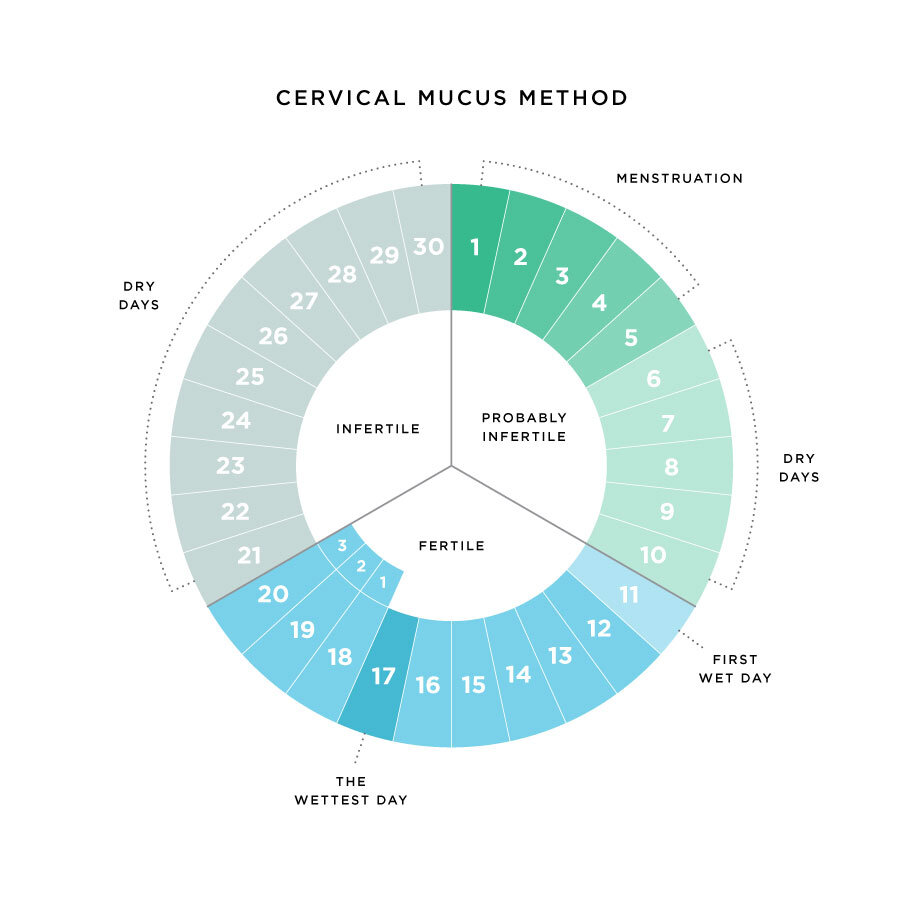What are Fertility Awareness Methods
Fertility awareness methods allow the opportunity for people to track their cycle, with the goal of knowing when ovulation occurs. There are a variety of methods (as listed below) and are about 76-88% effective, with a possible increase in effectiveness if you use multiple methods together.
With most of these methods, it's wise to track your period and these particular signs for at least 3 months (6 months for calendar methods) to get an idea of your body's rhythms before you use any of the methods for contraception.
The Temperature Method
If you've been following my blog for a while, you might remember a blog post discussing basal body temperature and fertility.
A quick recap: body temperature changes throughout the menstrual cycle. It's lower in the follicular phase and slightly higher in the luteal phase. This slight rise in temperature occurs after ovulation, and happens after the formation of the corpus luteum which releases progesterone (the hormone responsible for the temperature change).
By following this method, you would measure your basal body temperature everyday and chart it (on an app or on paper).
Days are considered safe once 3 days has passed since the initial rise of temperature, as well as a drop in temperature before the onset of the next menstrual cycle. This is an opportune time to have unprotected vaginal sex (with or without ejaculation).
During your fertile days, you can avoid sex or use another birth control method.
The Cervical Fluid Method (The Billings Method)
This method is based on cervical fluid changes, another topic I covered a while back.
A quick recap: During the follicular phase, increasing estrogen levels will lead to the production of cervical fluid. Cervical fluid will change in colour, texture, and amount during the period, and is considered especially fertile around ovulation.
Similar to the Temperature Method, cervical fluid needs to be charted everyday, starting from the end of the menstrual cycle. The changes that you may see will give you an idea of when ovulation may occur - which is great if you are hoping for pregnancy (unlike temperature, where it tells you that ovulation has passed). Record everything daily: your period days, dry days, wet days, sticky days, cloudy days, and slippery days.
There are 3 ways to check your cervical fluid: (1) Before urination, wipe the opening of your vagina with white toilet paper or tissue. Observe the colour and feel of the fluid. (2) Look at your underwear for any discharge - note the colour and texture. (3) Insert your clean fingers into your vagina, and note the colour and texture of cervical fluid on your fingers. The best way to feel the consistency of your fluid is to rub it and stretch it between your thumb and index finger.
This fertility awareness method may not be best for people who don't generally produce any cervical fluid.

The Symptothermal Method
This method combines cervical fluid, cervix changes, basal body temperature, and calculation to determine the beginning and the end of the fertile period. At the very least, you should be tracking cervical fluid and basal body temperature to determine when to avoid or engage in sex (depending on your goals, obviously).
The Calendar Method (The Rhythm Method)
This is one of the methods that need at least 6 months of charting your period.
Mark the first day of your cycle on an app or on a calendar. Remember, the first day is when you notice significant bleeding - not spotting. Mark the first day of your next cycle. Count the number of days in between your period. You'll find the fertile part of your cycle, once you subtract 18-21 days from the shortest cycle (of the 6 cycles that you have tracked). You would find the end of the fertile part of your cycle by subtracting 9-11 days from your longest menstrual cycle.
A real life example:
Dec - Jan = 30 days
Jan - Feb = 33 days
Feb - Mar = 28 days
Mar - April = 26 days
April - May = 32 days
May - June = 27 days
My shortest cycle was 26 days
My longest cycle was 33 days
Start of my fertile phase is (26 days - 21 days) and (26 days - 18 days) = Days 5 to 8
End of my fertile phase is (33 days - 11 days) and (33 days - 9 days) = Days 22 to 24
Therefore, I would be considered fertile between days 5 to 24 of my period. Many couples may find this way a bit constricting, and may need to have another means of contraception if they still want to engage in vaginal sex.
This method may be unreliable if you experience irregular menstrual cycles.
The Standard Days Method
This fertility awareness method identifies a standard window in which someone may be fertile. You can only use this method if your cycle is really regular and is never shorter than 26 days and never longer than 32 days. You must also be cool with not having vaginal sex or using another contraceptive method between days 8 and 19 of your cycle - as they are considered the most fertile.
Final Thoughts
There are at least 5 ways of practicing fertility awareness. Your best bet is paying attention to your basal body temperature and cervical mucus, and doing so for at least 3 cycles if you're choosing this as your primary method of birth control. Speak to your Naturopathic or Medical Doctor to determine if these methods are right for you.
